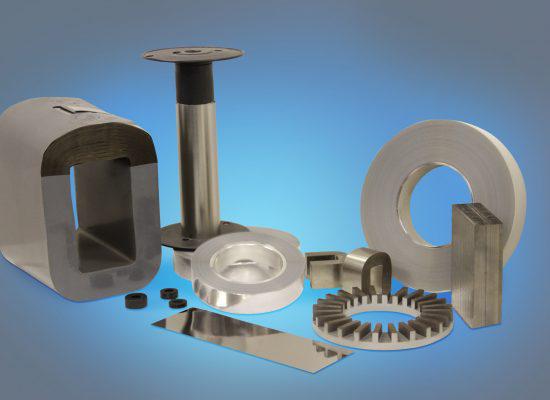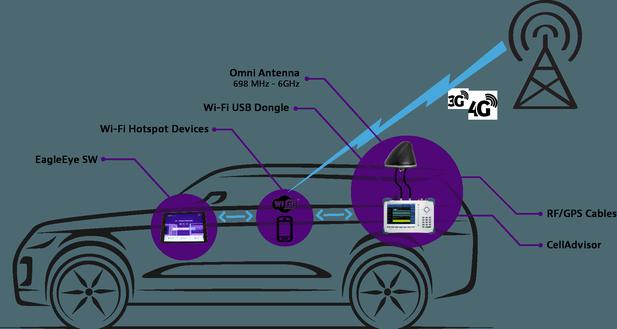Soft magnetic core
Common magnetic performance parameters of soft magnetic materials
Saturation magnetic induction intensity bs: Its size depends on the composition of the material, and its corresponding physical state is the orderly arrangement of the magnetization vector inside the material. Residual magnetic induction intensity br: is the characteristic parameter on the hysteresis loop, the value of b when h returns to 0. Rectangle ratio: br∕bs Coercivity hc: It is the amount that indicates the degree of difficulty of magnetization of the material, which depends on the composition and defects of the material (impurities, stress, etc.). Permeability μ: It is the ratio of b to h corresponding to any point on the hysteresis loop, which is closely related to the working state of the device. Initial permeability μi, maximum permeability μm, differential permeability μd, amplitude permeability μa, effective permeability μe, pulse permeability μp. Curie temperature tc: The magnetization of a ferromagnetic substance decreases with increasing temperature. When a certain temperature is reached, the spontaneous magnetization disappears and turns into paramagnetism. The critical temperature is the Curie temperature. It determines the upper limit temperature of the magnetic device. Loss p: hysteresis loss ph and eddy current loss pe p = ph + pe = af + bf2+ c pe ∝ f2 t2 /, ρ decreases, The method of hysteresis loss ph is to reduce the coercive force hc; the method to reduce eddy current loss pe is Reduce the thickness t of the magnetic material and increase the resistivity ρ of the material. The relationship between the loss of the magnetic core and the temperature rise of the magnetic core in free still air is: total power dissipation (mw)/surface area (cm2)
Features
The characteristics of powder cores are as follows :
Magnetic powder core
Magnetic powder core is a soft magnetic material made of ferromagnetic powder and insulating medium. Because the ferromagnetic particles are very small (0.5-5 microns used at high frequencies) and are separated by non-magnetic electrical insulating film materials, on the one hand, the eddy current can be isolated, and the material is suitable for higher frequencies; on the other hand, due to the particles The gap effect between these leads to the material's low permeability and constant permeability characteristics; and because of the small particle size, skin collection basically does not occur, and the permeability changes with frequency are relatively stable. Mainly used for high frequency inductors. The magnetic and electrical properties of magnetic powder cores mainly depend on the permeability of the powder material, the size and shape of the particles, their filling factor, the content of the insulating medium, the forming pressure and the heat treatment process.
There are three commonly used magnetic powder cores: iron powder core, permalloy powder core and sendust core.
The effective permeability μe and inductance of the magnetic core are calculated by the formula: μe = DL/4N2S × 109
where: D is the average core diameter (cm), and L is Inductance (share), N is the number of turns, S is the effective cross-sectional area of the core (cm2).

Iron powder core
Commonly used iron powder core is composed of carbon-based ferromagnetic powder and resin carbon-based ferromagnetic powder. The lowest price in the powder core. The saturation magnetic induction value is about 1.4T; the magnetic permeability ranges from 22 to 100; the initial permeability μi varies with frequency and has good stability; the direct current superposition performance is good; but the loss is high at high frequency.
Permalloy powder cores
Permalloy powder cores mainly include molybdenum permalloy powder cores (MPP) and high flux powder cores (High Flux).
MPP
is composed of 81% Ni, 2% Mo and Fe powder. The main features are: the saturation magnetic induction intensity value is about 7500Gs; the magnetic permeability range is from 14 to 550; it has the lowest loss in the powder magnetic core; the temperature stability is excellent, and it is widely used in space equipment, outdoor equipment, etc.; magnetic The strain coefficient is close to zero, and no noise is generated when working at different frequencies. Mainly used in high quality factor Q filters below 300kHz, inductive load coils, resonant circuits, commonly used in LC circuits with high temperature stability requirements, output inductance, power factor compensation circuits, etc.,
Commonly used in AC circuits, the price of powder core is the most expensive.
High magnetic flux powder core HF is composed of 50% Ni and 50% Fe powder. The main features are: the saturation magnetic induction intensity value is about 15000Gs; the magnetic permeability ranges from 14 to 160; it has the highest magnetic induction intensity and the highest DC bias capability among the powder magnetic cores; the magnetic core is small in size. It is mainly used in line filters, AC inductors, output inductors, power factor correction circuits, etc. It is commonly used in DC circuits, and it is used more for high DC bias, high DC and low AC. The price is lower than MPP.
Kool Mμ Cores
Kool Mμ Cores are composed of 6% Al, 9% Si, and 85% Fe powder. Mainly to replace iron powder core, the loss is 80% lower than that of iron powder core, and it can be used at frequencies above 8kHz; saturation magnetic induction is around 1.05T; magnetic permeability is from 26 to 125; magnetostriction coefficient is close to 0, at different frequencies There is no noise when it is working down; it has a higher DC bias capability than MPP; it has the best performance-to-price ratio. Mainly used in AC inductors, output inductors, line filters, power factor correction circuits, etc. Sometimes it is also used as a transformer core instead of air gap ferrite.
Types of commonly used soft magnetic cores
Three ferromagnetic elements, iron, cobalt, and nickel, are the basic components of magnetic materials. According to the product form classification (main components, magnetic characteristics, structural characteristics): (1) Powder core: Magnetic powder core, including: iron powder core, sendust core, high flux powder core (high flux), permalloy powder Core (mpp), ferrite core (2) Band wound core: silicon steel sheet, permalloy, amorphous and nanocrystalline alloys
Development of soft magnetic materials
By the beginning of the 20th century, silicon steel sheets were developed to replace low-carbon steel, which improved the efficiency of transformers and reduced losses. Silicon steel sheet still ranks first among soft magnetic materials used in the power industry. In the 1920s, the rise of radio technology promoted the development of high-permeability materials, and permalloy and permalloy magnetic powder cores appeared. From the 1940s to the 1960s, it was a period of rapid development of science and technology. Radar, television broadcasting, the invention of integrated circuits, etc. required higher requirements for soft magnetic materials, and produced soft magnetic alloy ribbons and soft ferrite materials. . In the 1970s, with the development of telecommunications, automatic control, and computer industries, soft magnetic alloys for magnetic heads were developed. In addition to the traditional crystalline soft magnetic alloys, another type of material-amorphous soft magnetic alloys emerged. .
Latest: Pseudocrystalline growth technology
Next: Saturation magnetization








